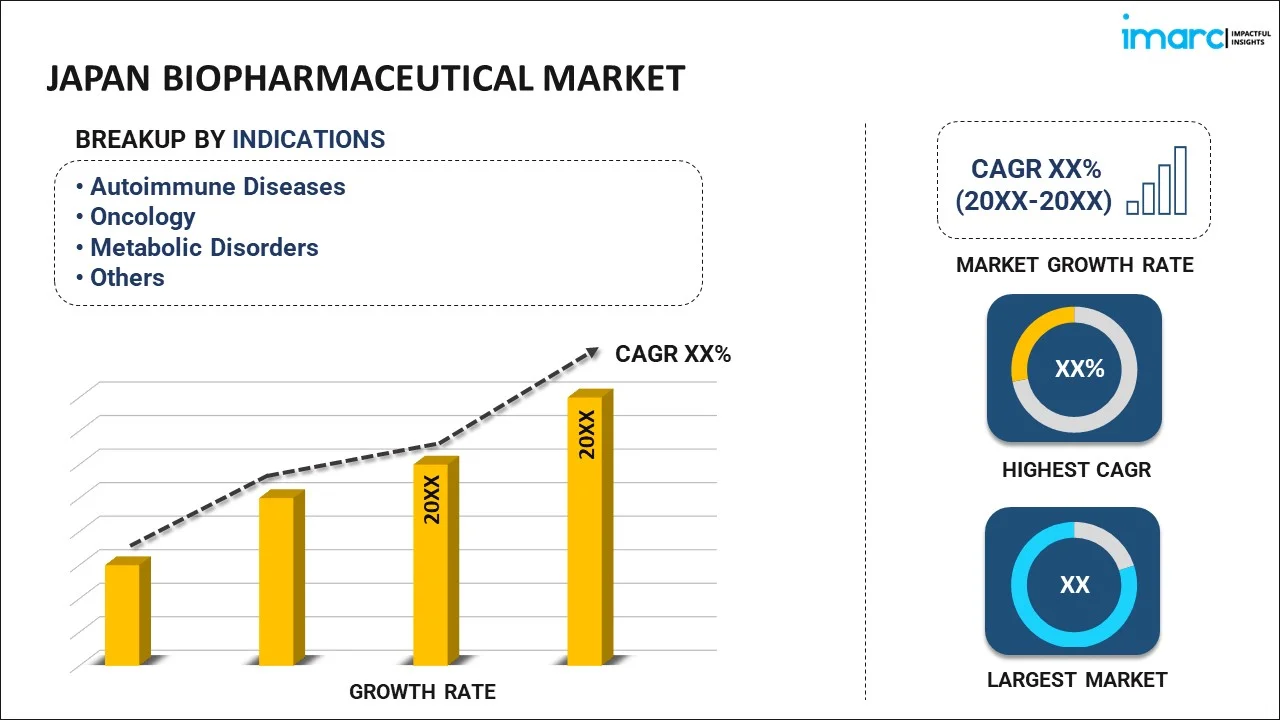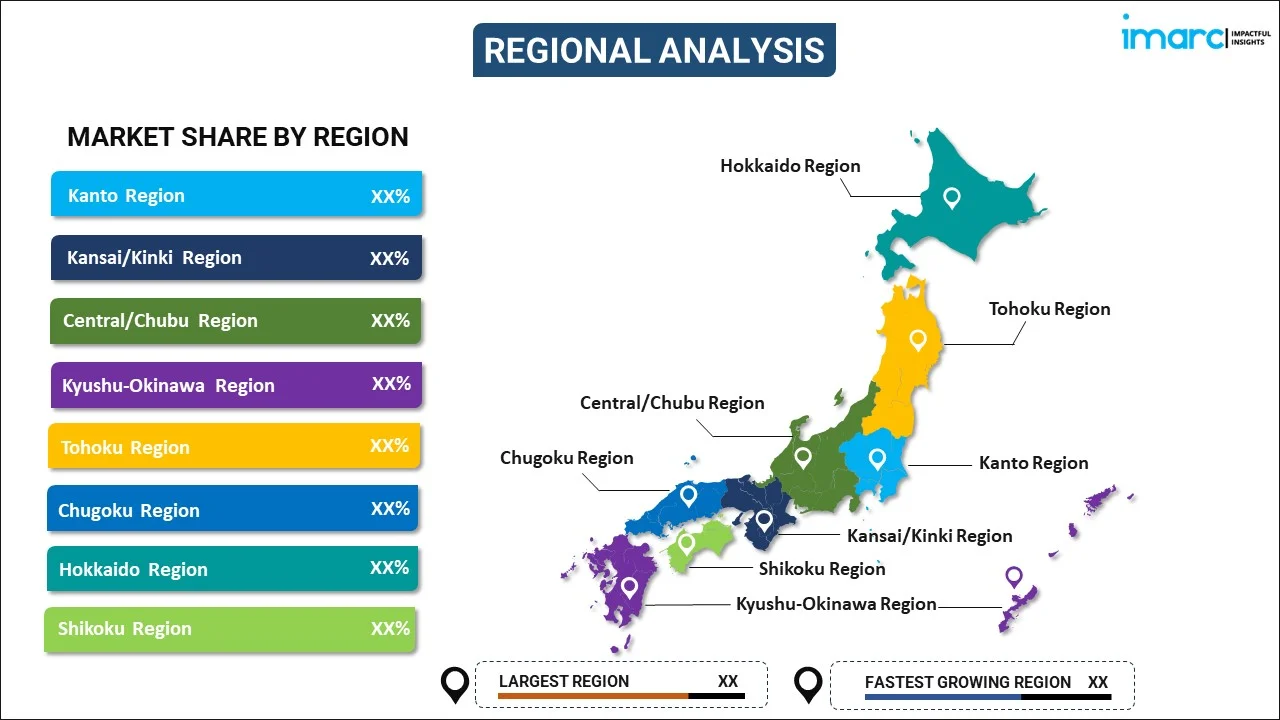
Japan Biopharmaceutical Market Report by Indication (Autoimmune Diseases, Oncology, Metabolic Disorders, and Others), Class (Recombinant Proteins, Monoclonal Antibodies, Purified Proteins), and Region 2026-2034
Market Overview:
Japan biopharmaceutical market size reached USD 24.6 Billion in 2025. Looking forward, IMARC Group expects the market to reach USD 36.5 Billion by 2034, exhibiting a growth rate (CAGR) of 4.51% during 2026-2034. The market is experiencing growth due to several key factors, including an increasing need for customized medicines, the rising incidence of chronic and lifestyle-related illnesses, and rapid advancements in biotechnology, particularly in areas like genetic engineering and recombinant DNA technology.
|
Report Attribute
|
Key Statistics
|
|---|---|
|
Base Year
|
2025 |
|
Forecast Years
|
2026-2034 |
|
Historical Years
|
2020-2025
|
| Market Size in 2025 | USD 24.6 Billion |
| Market Forecast in 2034 | USD 36.5 Billion |
| Market Growth Rate (2026-2034) | 4.51% |
Biopharmaceuticals, also referred to as biologics, belong to a category of pharmaceutical medications that originate from biological sources. These drugs are manufactured through biotechnological processes utilizing living organisms such as bacteria, yeast, or mammalian cells. In contrast to conventional small-molecule drugs synthesized chemically, biopharmaceuticals are characterized by their large and intricate molecular structures, which allow them to engage in highly precise interactions with biological targets within the body. Biopharmaceuticals offer numerous advantages over traditional pharmaceuticals. They often demonstrate a remarkable degree of specificity in their action, frequently targeting particular receptors or molecules. This specificity typically leads to enhanced effectiveness and a reduction in adverse side effects. Moreover, biopharmaceuticals hold the potential to treat diseases that were historically challenging to address using conventional drug approaches.
Japan Biopharmaceutical Market Trends:
In Japan, several factors are contributing to substantial market growth. Firstly, there is a notable surge in demand for personalized medicine, which is a significant driver. Additionally, the increased adoption of biopharmaceuticals for treating conditions such as cancer, diabetes, psoriasis, and rheumatoid arthritis is another key factor fueling this growth. Furthermore, there is a growing awareness among the general population regarding the effectiveness and accessibility of biopharmaceuticals, further propelling the regional market. Moreover, there is a heightened focus on addressing rare diseases and developing orphan drugs, which is driving market growth. These rare diseases, often characterized by small patient populations, present significant unmet medical needs. Besides this, governments and regulatory agencies have introduced incentives and streamlined regulatory processes to encourage the development of therapies for these conditions, which is acting as another significant growth-inducing factor. Furthermore, biopharmaceutical companies are actively investing in research and development (R&D) efforts to create orphan drugs targeting rare diseases. This approach not only addresses critical medical needs but also creates opportunities for expanding the market over the forecasted period.
Japan Biopharmaceutical Market Segmentation:
IMARC Group provides an analysis of the key trends in each segment of the market, along with forecasts at the country level for 2026-2034. Our report has categorized the market based on indication and class.
Indication Insights:

- Autoimmune Diseases
- Oncology
- Metabolic Disorders
- Others
The report has provided a detailed breakup and analysis of the market based on the indication. This includes autoimmune diseases, oncology, metabolic disorders, and others.
Class Insights:
- Recombinant Proteins
- Monoclonal Antibodies
- Purified Proteins
A detailed breakup and analysis of the market based on the class have also been provided in the report. This includes recombinant proteins, monoclonal antibodies, and purified proteins.
Regional Insights:

- Kanto Region
- Kansai/Kinki Region
- Central/ Chubu Region
- Kyushu-Okinawa Region
- Tohoku Region
- Chugoku Region
- Hokkaido Region
- Shikoku Region
The report has also provided a comprehensive analysis of all the major regional markets, which include Kanto Region, Kansai/Kinki Region, Central/ Chubu Region, Kyushu-Okinawa Region, Tohoku Region, Chugoku Region, Hokkaido Region, and Shikoku Region.
Competitive Landscape:
The market research report has also provided a comprehensive analysis of the competitive landscape. Competitive analysis such as market structure, key player positioning, top winning strategies, competitive dashboard, and company evaluation quadrant has been covered in the report. Also, detailed profiles of all major companies have been provided.
Japan Biopharmaceutical Market News:
- May 2025: Mycenax began the commercial production of its initial internationally approved biopharmaceutical in Japan. This project required a transfer of technology from the client to Mycenax. Upon fulfilling all process validation criteria and successive GMP batch productions mandated by regulatory bodies, Mycenax secured official PMDA site transfer authorization. This accomplishment not only strengthened the firm’s foothold in the Japanese CDMO market but also signified a crucial milestone in the company's growth in Japan.
- May 2025: Kidswell Bio Corporation revealed that it, along with Alfresa Holdings Corporation and Chiome Bioscience Inc., were chosen under the Japanese Ministry of Health, Labour and Welfare (MHLW)’s funding initiative named ‘Subsidy Program for the Development of Domestic Biosimilar Manufacturing Facilities for Biosimilars’. Kidswell was dedicated to fostering the growth of highly competent professionals in biopharmaceutical development and manufacturing, along with promoting the overall progress of the biopharmaceutical sector in Japan.
- April 2025: Fujifilm of Japan secured a biopharmaceutical agreement valued at USD 3 Billion. It would produce biologic medications derived from living organisms. The strategy to boost local medicine production would lead to swift progress.
- April 2025: Kyowa Kirin Co., Ltd. announced the completion of a drug substance (DS) production facility at its biopharmaceutical development site in Takasaki Plant. The HB7 building was constructed to produce DS for biopharmaceuticals using Kyowa Kirin's cutting-edge protein engineering and antibody technology.
- April 2025: Adragos Pharma broadened its footprint in Japan, placing a strong emphasis on improving its manufacturing abilities at the Kawagoe facility in Saitama Prefecture. This plant aimed to boost its solid dosage production capacity to 1 Billion tablets, with intentions to expand to a 2 Billion tablet system. Moreover, Adragos Pharma investigated wider prospects in the biopharmaceutical industry, encompassing biosimilars, and evaluated investments in innovative technologies like vial and pre-filled syringe filling machinery to enhance its service portfolio.
- February 2025: JCR Pharmaceuticals Co., Ltd. declared that it commenced building a new facility for drug product filling and finishing at the Kobe Science Park Center, Japan. CR, in collaboration with the nearby API facility, would build the plant with the assistance of funds from the ‘Project for Establishing Biopharmaceutical Manufacturing Sites to Strengthen Vaccine Production’ approved by the Japanese Ministry of Economy, Trade and Industry. The goal was to create a unified plant system for contract production of vaccines during a pandemic crisis.
Japan Biopharmaceutical Market Report Coverage:
| Report Features | Details |
|---|---|
| Base Year of the Analysis | 2025 |
| Historical Period | 2020-2025 |
| Forecast Period | 2026-2034 |
| Units | Billion USD |
| Scope of the Report | Exploration of Historical and Forecast Trends, Industry Catalysts and Challenges, Segment-Wise Historical and Predictive Market Assessment:
|
| Indications Covered | Autoimmune Diseases, Oncology, Metabolic Disorders, Others |
| Classes Covered | Recombinant Proteins, Monoclonal Antibodies, Purified Proteins |
| Regions Covered | Kanto Region, Kansai/Kinki Region, Central/ Chubu Region, Kyushu-Okinawa Region, Tohoku Region, Chugoku Region, Hokkaido Region, Shikoku Region |
| Customization Scope | 10% Free Customization |
| Post-Sale Analyst Support | 10-12 Weeks |
| Delivery Format | PDF and Excel through Email (We can also provide the editable version of the report in PPT/Word format on special request) |
Key Benefits for Stakeholders:
- IMARC’s industry report offers a comprehensive quantitative analysis of various market segments, historical and current market trends, market forecasts, and dynamics of the Japan biopharmaceutical market from 2020-2034.
- The research report provides the latest information on the market drivers, challenges, and opportunities in the Japan biopharmaceutical market.
- Porter's five forces analysis assist stakeholders in assessing the impact of new entrants, competitive rivalry, supplier power, buyer power, and the threat of substitution. It helps stakeholders to analyze the level of competition within the Japan biopharmaceutical industry and its attractiveness.
- Competitive landscape allows stakeholders to understand their competitive environment and provides an insight into the current positions of key players in the market.
Key Questions Answered in This Report
The biopharmaceutical market in Japan was valued at USD 24.6 Billion in 2025.
The Japan biopharmaceutical market is projected to exhibit a CAGR of 4.51% during 2026-2034, reaching a value of USD 36.5 Billion by 2034.
Collaborations between domestic firms and international pharmaceutical companies are accelerating product development and market expansion. Additionally, the growing awareness about cutting-edge treatments and improved healthcare access is contributing to rising patient demand for biopharmaceuticals. Technological advancements in genomics, molecular biology, and drug delivery systems are also supporting the development of novel biologics.
Need more help?
- Speak to our experienced analysts for insights on the current market scenarios.
- Include additional segments and countries to customize the report as per your requirement.
- Gain an unparalleled competitive advantage in your domain by understanding how to utilize the report and positively impacting your operations and revenue.
- For further assistance, please connect with our analysts.
 Request Customization
Request Customization
 Speak to an Analyst
Speak to an Analyst
 Request Brochure
Request Brochure
 Inquire Before Buying
Inquire Before Buying




.webp)




.webp)












